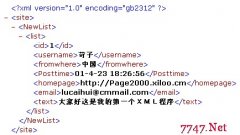Asp使用request.ServerVariables
来源:网络整理 责任编辑:admin 发表时间:2013-07-02 06:49 点击:次
当讨论Request对象内容时,要研究的集合之一就是ServerVariables集合。这个集合包含了两种值的结合体,一种是随同页面请求从客户端发送到服务器的HTTP报头中的值,另外一种是由服务器在接收到请求时本身所提供的值。
ServerVariables集合中值的使用方式:
"自引用"页面
在ServerVariables集合中返回的值包含Web服务器的详细信息和当前页面的路径信息。在任何地方创建一个页面都可使用这些信息。例如创建一个“自引用”页面,此页面能够再次调用自身完成另一项任务,我们可以用以下代码:
<FORM ACTION=”<% = Request.ServerVariables(“PATH_INFO”) %>” METHOD=”POST”>
同样的效果可以用HTTP的“script_NAME”值获得:
<FORM ACTION=”<% = Request.ServerVariables(“script_NAME”) %>” METHOD=”POST”>
使用<A>元素打开一个不同页,可以使用:
...
<%
strFullPath = Request.ServerVariables(“PATH_INFO”)
‘Strip off the file name
strPathOnly = Left(strFullPath, InStrRev(strFullPath, “/”))
strNextPage = strPathOnly & “pages/next_page.asp”
%>
...
<A HREF=”<% = strNextPage %>”>Next Page</A>
...
即使原始页面的名称或位置发生变化,这些实例都能正常工作,因为使用了当前页面的路径信息(当然,第二个例子在分离的目标页的名称发生变化时运行会失败)。
换句话说,如果为搜索引擎的子会话自动建立URL,可以收集ServerVariable的一些值:
strFullURL = http:// & Request.ServerVariables(“LOCAL_ADDR”) _
& “:” & Request.ServerVariables(“SERVER_PORT”) _
& Request.ServerVariables(“PATH_INFO”)
这将创建一个完整的URL包括端口号(这种情况下,不是标准值80)。例如,结果可能是:
http://194.74.60.254:1768/thispath/thispage.asp
这个就是一个完整的url。
检测浏览器的版本
ServerVariables集合中,另外一个有用的值是用户浏览器的用户代理字符串。使用ServerVariables集合中的“HTTP_USER_AGENT”值来获得用户代理字符串,一些脚本用来解析该信息并寻找生产厂家名称和浏览器版本。
<%
strUA = Request.ServerVariables(“HTTP_USER_AGENT”)
Response.Write “The User Agent string is <B>” & strUA & “</B><P>”
If InStr(strUA, “MSIE”) Then
Response.Write “To upgrade your browser go to “_
& “<A HREF=” & Chr(34) & http://www.microsoft.com/ie/”_
& Chr(34) & “>http://www.microsoft.com/ie/<A></P>”
intVersion = Cint(Mid(strUA, InStr(strUA, “MSIE”) + 5, 1))
If intVersion >=4 Then
Response.Write “You can use Microsoft Dynamic HTML”
End If
Else
If InStr(strUA, “Mozilla”) Then
If InStr(strUA, “compatible;”) = 0 Then
Response.Write “Your browser is probably Navigator. You can “_
& “download the latest version of Navigator from “_
& “<A HREF=” & Chr(34) & http://home.netscape.com/”_
& “download/”& Chr(34) & “>http://home.netscape.com”_
& “/download/</A></P>”
ServerVariables集合中值的使用方式:
"自引用"页面
在ServerVariables集合中返回的值包含Web服务器的详细信息和当前页面的路径信息。在任何地方创建一个页面都可使用这些信息。例如创建一个“自引用”页面,此页面能够再次调用自身完成另一项任务,我们可以用以下代码:
<FORM ACTION=”<% = Request.ServerVariables(“PATH_INFO”) %>” METHOD=”POST”>
同样的效果可以用HTTP的“script_NAME”值获得:
<FORM ACTION=”<% = Request.ServerVariables(“script_NAME”) %>” METHOD=”POST”>
使用<A>元素打开一个不同页,可以使用:
...
<%
strFullPath = Request.ServerVariables(“PATH_INFO”)
‘Strip off the file name
strPathOnly = Left(strFullPath, InStrRev(strFullPath, “/”))
strNextPage = strPathOnly & “pages/next_page.asp”
%>
...
<A HREF=”<% = strNextPage %>”>Next Page</A>
...
即使原始页面的名称或位置发生变化,这些实例都能正常工作,因为使用了当前页面的路径信息(当然,第二个例子在分离的目标页的名称发生变化时运行会失败)。
换句话说,如果为搜索引擎的子会话自动建立URL,可以收集ServerVariable的一些值:
strFullURL = http:// & Request.ServerVariables(“LOCAL_ADDR”) _
& “:” & Request.ServerVariables(“SERVER_PORT”) _
& Request.ServerVariables(“PATH_INFO”)
这将创建一个完整的URL包括端口号(这种情况下,不是标准值80)。例如,结果可能是:
http://194.74.60.254:1768/thispath/thispage.asp
这个就是一个完整的url。
检测浏览器的版本
ServerVariables集合中,另外一个有用的值是用户浏览器的用户代理字符串。使用ServerVariables集合中的“HTTP_USER_AGENT”值来获得用户代理字符串,一些脚本用来解析该信息并寻找生产厂家名称和浏览器版本。
<%
strUA = Request.ServerVariables(“HTTP_USER_AGENT”)
Response.Write “The User Agent string is <B>” & strUA & “</B><P>”
If InStr(strUA, “MSIE”) Then
Response.Write “To upgrade your browser go to “_
& “<A HREF=” & Chr(34) & http://www.microsoft.com/ie/”_
& Chr(34) & “>http://www.microsoft.com/ie/<A></P>”
intVersion = Cint(Mid(strUA, InStr(strUA, “MSIE”) + 5, 1))
If intVersion >=4 Then
Response.Write “You can use Microsoft Dynamic HTML”
End If
Else
If InStr(strUA, “Mozilla”) Then
If InStr(strUA, “compatible;”) = 0 Then
Response.Write “Your browser is probably Navigator. You can “_
& “download the latest version of Navigator from “_
& “<A HREF=” & Chr(34) & http://home.netscape.com/”_
& “download/”& Chr(34) & “>http://home.netscape.com”_
& “/download/</A></P>”
相关新闻>>
最新推荐更多>>>
- 发表评论
-
- 最新评论 进入详细评论页>>


